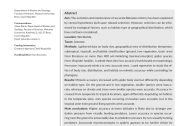Obsah
Aim: The evolution and maintenance of accurate Batesian mimicry has been explained by several hypotheses built upon relaxed selection. However, selection can be influenced by ecological factors, such as habitat type or geographical distribution, which have not been considered.
Location: Worldwide.
Taxon: Araneae.
Methods: I gathered data on body size, geographical area of distribution (temperate, subtropical, tropical), and habitat stratification (ground, low vegetation, bush, tree) from literature on more than 400 ant-mimicking (myrmecomorphic) spider species from 18 spider families. I ranked them into four accuracy levels based on morphology, from poor inaccurate mimics to very accurate ones. I used regression to study the effect of body size, distribution, and habitat on mimetic accuracy while controlling for phylogeny.
Results: Mimetic accuracy increased with spider body size but differently depending on habitat type. On the ground and in low vegetation, smaller species were inaccurate
whereas on shrubs and trees even smaller species were accurate. Accuracy increased from temperate to tropical locations, again differently depending on habitat. In the temperate zone, only species occurring on bushes were accurate, but in the tropical zone even ground-living species were accurate.
Main conclusions: Higher accuracy at lower latitudes is likely due to stronger predation pressure from visually hunting predators. Lower accuracy in species occurring near the ground is presumably due to predation pressure by non-visually hunting predators. Inaccurate myrmecomorphy in spiders appears to be further driven by smaller body size due to lower profitability to predators
and higher latitude due to increased occurrence of generalist predators.



